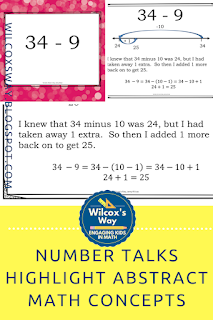1. Number talks are a great chance to show kids that fraction operations can actually "make sense". A common strategy to mentally solve the problem 18 x 5 is to use the distributive property. Students think of 18 as 10 and 5, then multiply 10 x 5 and get 50, multiply 8 x 5 and get 40, then add 50 and 40 to get 90. After seeing this strategy in number talks, think what a powerful lesson this can be for your students about why 4 1/2 x 6 is not 24 1/2. Using similar reasoning as before, students may begin to understand that 4 1/2 is really 4 and 1/2, and you must multiply 4 x 6 AND 1/2 x 6 to get the solution to 4 1/2 x 6.
2. Number talks are a fantastic tool to build a growth mindset as students begin to see just how complex their thinking really it. As students explain their strategies to solve a problem mentally, take a moment and really show students all of the steps that they are completing mentally. Again, going back to the example of 18 x 5, using equations to show each step of their thinking might look like this:
18 x 5 = (10 + 8) x 5 = 10 x 5 + 8 x 5 = 50 + 40 = 90
What a great chance to build students up. Can't you hear yourself saying this to a student, "Wow! That's pretty amazing. When you write all those steps out it looks pretty complicated, and you were able to think that through in your head. Imagine what you'll be able to do if we keep practicing!"
3. Number talks show students that mathematical properties (like commutative, associative, distributive, and substitution) really ARE important...and that they're actually using them all the time! I don't know about you, but I've got quite a few students that think things like the distributive and commutative properties are just dumb stuff you learn in math class, NEVER to be used again. In reality, these properties are the foundation of many mental math strategies that are commonly used. Again, by connecting your number talks back to the written equations that represent student thinking, you have a great opportunity to highlight these foundational concepts and vocabulary.
4. Number talks are a great way to connect multiple representations of a strategy. As students verbally explain their thinking, you can connect it to equations and visual models. This is a great way for students to see their work formalized. After students explain their thinking you could also use a visual model such as a number line or area model. As students see and get used to these models, they can begin adding them to their mental toolbox to help them visualize and conceptualize math.
5. Number talks can highlight some pretty abstract math concepts (like showing that subtracting a negative is like adding a positive). When I started thinking about the problem 34 - 9, one strategy was to subtract 10 and then add back 1 since you subtracted too much. As I wrote the equation to match this, I had a total "A-ha moment"! Here was my equation:
34 - 9 = 34 - (10 - 1) = 34 - 10 + 1 = 24 + 1 = 25
What a concrete example of when subtracting a negative is really positive!6. Number talks exemplify what the mathematical practices are all about. Honestly, as I started writing this I realized this one point could be it's one post.....so why not! If you want to read in-depth how number talks do this, click here to find my blog post about how number talks support the math practices. Without question, number talks will help students construct viable arguments and critique reasoning of others...it's basically the whole point of a number talk, right? Kids share different strategies, give you a chance to compare and contrast strategies. If you combine your number talks with multiple representations or visual models, then you've also got math practice #4, model with mathematics. Math practice 7, look for and make use of structure, also happens frequently with number talks. (Hint: Look back at reason #1. That's using the distributive property as the "structure" to make sense of fraction computations).
7. Number talks get kids excited to share....and NOT just the ones that always have their hand in the air. As I write this, I'm thinking of a particular student that I had in my 7th-hour class. He was a nice kid but saw little value in school. He usually missed 1 or 2 days a week. On the days that he came to school, he would come into class and every day and ask, "Mrs. Wilcox, are we playing a game today?" Games were basically the only time I ever got him to be involved in class. And then one day during a number talk, I see him waving his hand in the air, eager to be called on to tell me his strategy....ah, the taste of victory! Moments like these are what convinced me to make time in my classroom for number talks.
If you're ready to try out number talks today, click here to get some number talk freebies to help you get started! Click here to get a few more tips for planning. These resources will provide you problems and some sample solution slides that have visual models, written expressions and equations for some common strategies! Or if you're ready for everything you need for 100 number talks, get the bundle!




No comments:
Post a Comment